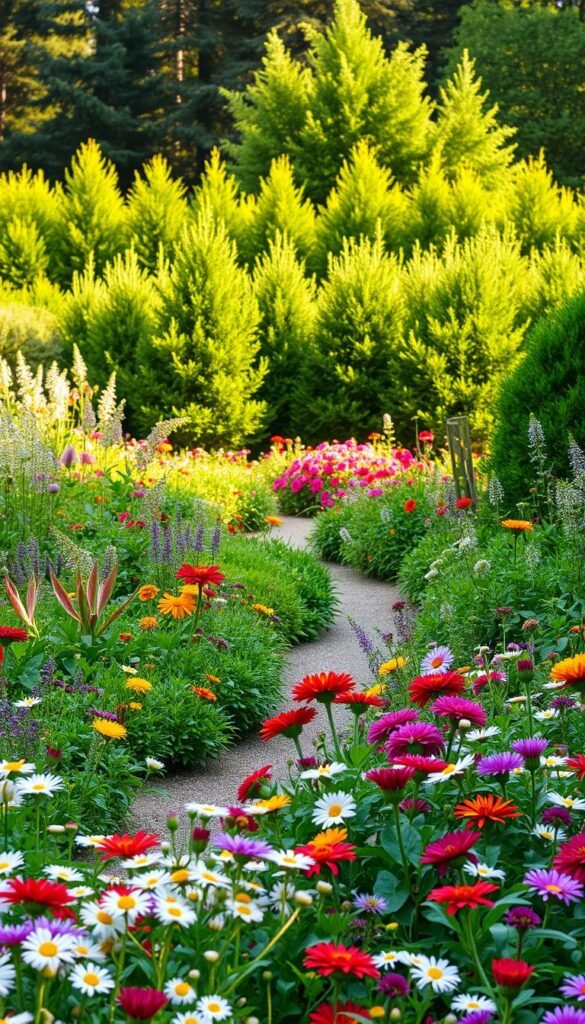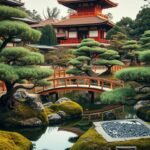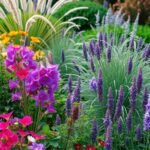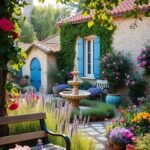Imagine stepping outside to a vibrant outdoor space that dazzles in every season. Crafting this kind of enduring beauty doesn’t require endless work—just smart plant choices and thoughtful design. Perennials shine here, offering reliable color and texture without yearly replanting. Whether you’re in sunny Texas or chilly Vermont, these plants adapt to your climate, soil, and light conditions.
Discover how to layer early spring bulbs with summer stars like long-blooming perennials such as coneflowers and black-eyed Susans. Pair them with fall-flowering salvias and winter-interest evergreens for nonstop visual appeal. This approach creates a natural rhythm, ensuring something’s always in bloom from thaw to frost.
Low-maintenance strategies make upkeep simple. Opt for drought-tolerant varieties suited to your USDA zone, or try low-maintenance flowers for raised beds to improve drainage and reduce bending. Many of these plants also support pollinators, turning your yard into a wildlife haven.
Ready to transform your space? Let’s explore designs that balance beauty and practicality, giving you four seasons of joy.
Introduction to Year-Round Perennial Blooms
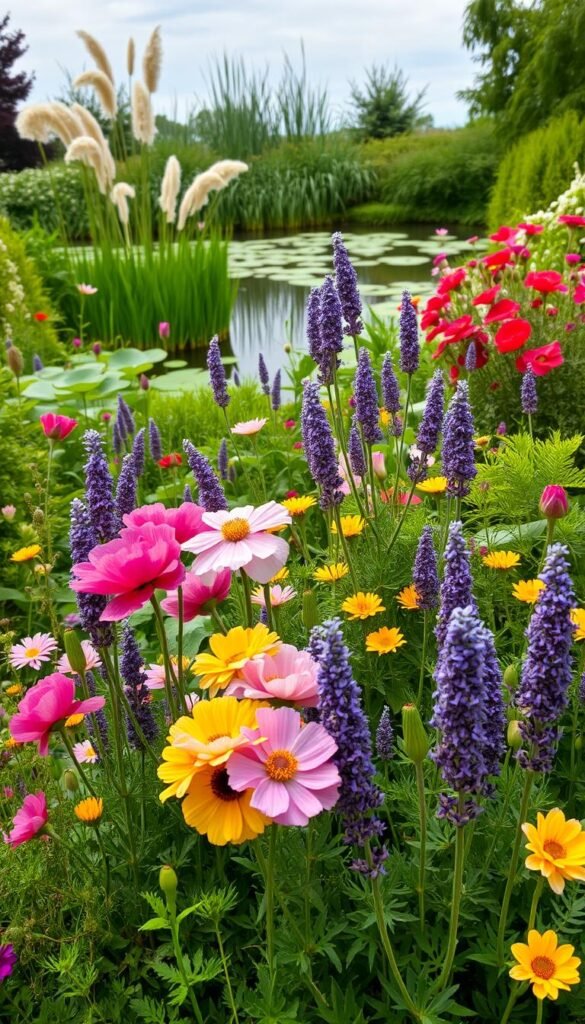
Creating a lively outdoor space that evolves with the seasons starts with plants that keep giving. Unlike annuals that vanish after one show, perennials grow stronger roots each year. This means less replanting and more time enjoying your yard’s natural rhythm.
Why Perennials Make a Difference
These hardy survivors save you money and effort. Once established, they return like clockwork—some live over 50 years. Peonies and daylilies, for example, become family heirlooms that outlast patio furniture. Their deep roots help them survive droughts, making them perfect for unpredictable weather.
“Perennials are the ultimate garden multitaskers—they feed pollinators, prevent soil erosion, and create structure,” notes Vermont horticulturist Lisa Mason.
The Benefits of Choosing Perennials for Your Garden
Beyond beauty, these plants support ecosystems. Bees flock to coneflowers in summer, while birds snack on black-eyed Susan seeds in fall. Even in winter, ornamental grasses add texture to frosty landscapes.
| Feature | Annuals | Perennials |
|---|---|---|
| Lifespan | 1 season | 3+ years |
| Cost Over Time | $$$ (yearly) | $ (one-time) |
| Wildlife Value | Limited | High |
Mix them with seasonal bulbs for pops of color. You’ll get a dynamic space that feels planned yet wild—a true habitat that grows wiser with age.
Your Guide to 10 Perennial Garden Ideas for Year-Round Blooms

Design a space where blossoms pass the spotlight like relay runners, ensuring no season feels left out. Whether you crave wildflower meadows or structured beds, these concepts solve common challenges while keeping your garden lively from January to December.
Pollinator-friendly layouts burst with coneflowers and bee balm, while cottage-style borders mix lavender and phlox for casual charm. Prefer clean lines? Try formal designs with repeating patterns of hostas and astilbes. Each style uses plants that bloom in sequence—early risers like bleeding hearts make way for summer’s daylilies, followed by autumn sedum.
Short on space? Compact varieties thrive in containers or narrow beds. Shade-loving coral bells brighten dark corners, while drought-resistant yarrow handles sunny slopes. Maintenance needs vary too: low-water succulents suit busy schedules, while flower fans might enjoy fussier peonies.
Deer-resistant choices like Russian sage protect your efforts, and clay-busting plants like black-eyed Susans improve tough soils. Mix classic favorites with lesser-known stars—try electric-blue sea holly alongside daisies for unexpected flair. Your yard becomes a living mosaic that adapts to weather swings and wildlife visits.
Understanding Seasonal Growing and Bloom Times
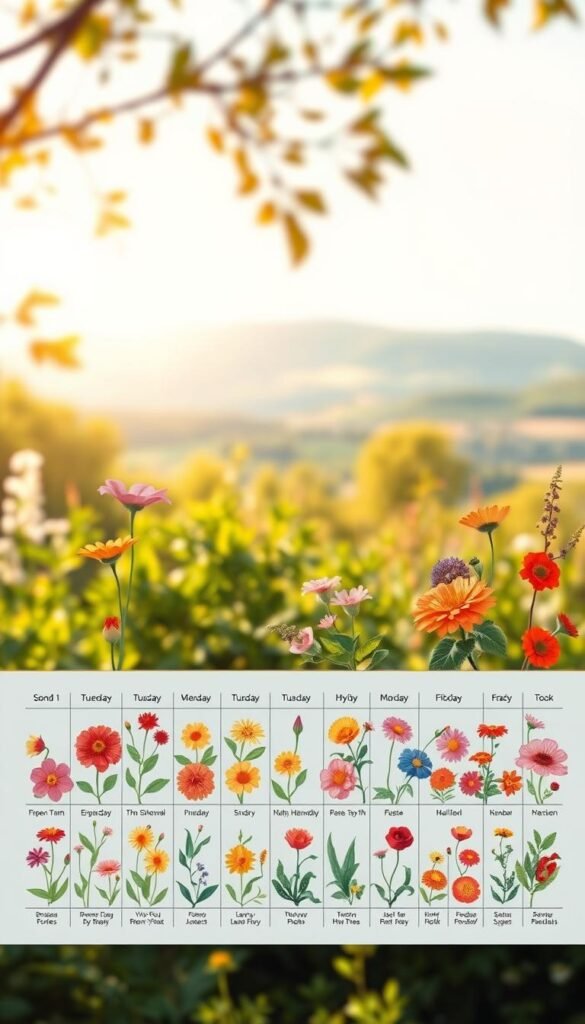
Timing is everything when building a landscape that transitions smoothly between seasons. To keep color flowing year-round, you’ll want to map out when different plants shine brightest. This rhythm depends on understanding each variety’s peak performance window.
Nature’s Calendar: Working With Seasons
Early risers like daffodils kick things off in late winter, their cheerful yellow trumpets defying frost. As spring warms up, peonies and irises take center stage. By summer, black-eyed Susans begin their marathon bloom—lasting until winter’s first freeze.
Hydrangeas act as anchors, offering months of color from late spring through early fall. When autumn arrives, asters burst open just as migrating butterflies need fuel. Even winter contributes texture through ornamental grasses and seed heads left standing.
Strategic Timing for Continuous Color
Overlap is key. Plant early summer bloomers beside fall stars so fading flowers get discreetly covered. Here’s a quick reference for popular choices:
| Season | Early Bloomers | Late Performers |
|---|---|---|
| Spring | Daffodils (Feb-Apr) | Peonies (May-Jun) |
| Summer | Daylilies (Jun-Jul) | Black-eyed Susan (Jul-Frost) |
| Fall | Asters (Aug-Sep) | Sedum (Sep-Nov) |
Adjust care routines seasonally too. Prune spring flowers after they fade, deadhead summer blooms weekly, and leave fall seed heads until spring for wildlife shelter. This approach keeps your space lively while supporting local ecosystems.
Mastering Hardiness Zones for Perennials
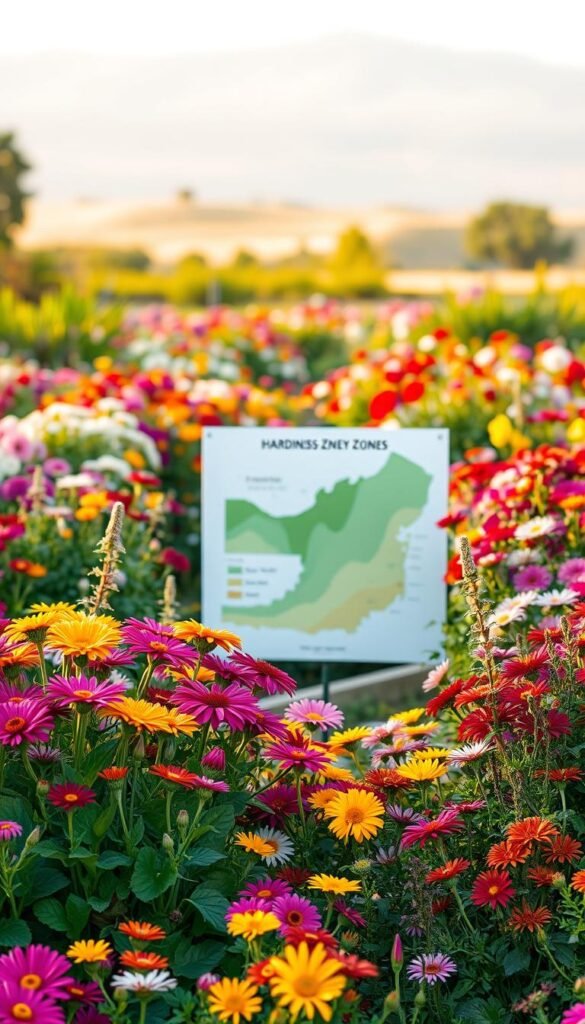
Ever wonder why some plants flourish while others barely survive? The secret lies in matching your selections to your local hardiness zone. These geographic regions, defined by average winter lows, dictate which species can handle your area’s coldest snaps.
Soil, Sunlight, and Zone Considerations
Bearded iris shows why zones matter. It grows from chilly zone 3 to balmy zone 10, as long as it gets full sun and well-drained soil. Meanwhile, lavender thrives in zones 5-9 but demands alkaline sandy soil—a dealbreaker for acidic gardens.
Black-eyed Susan proves adaptable, tolerating nearly any soil type in zones 3-9. Pair it with hydrangeas, which prefer partial sun and acidic soil in the same zones. This combo works where conditions vary across your yard.
| Plant | Zones | Sun Needs | Soil Type |
|---|---|---|---|
| Bearded Iris | 3-10 | Full | Neutral, well-drained |
| Black-eyed Susan | 3-9 | Full | Any well-draining |
| Hydrangea | 3-9 | Partial | Acidic, moist |
| Lavender | 5-9 | Full | Alkaline, sandy |
Roses highlight another layer—they need loamy soil in zones 5-8. Your site’s sun exposure also plays a role. Full-sun lovers like lavender won’t bloom in shade, while hydrangeas scorch in afternoon glare.
Get this mix right, and you’ll spend less time babying plants. They’ll establish stronger roots and handle weather swings, giving you more blooms with less work.
Creating a Vibrant Perennial Garden Layout
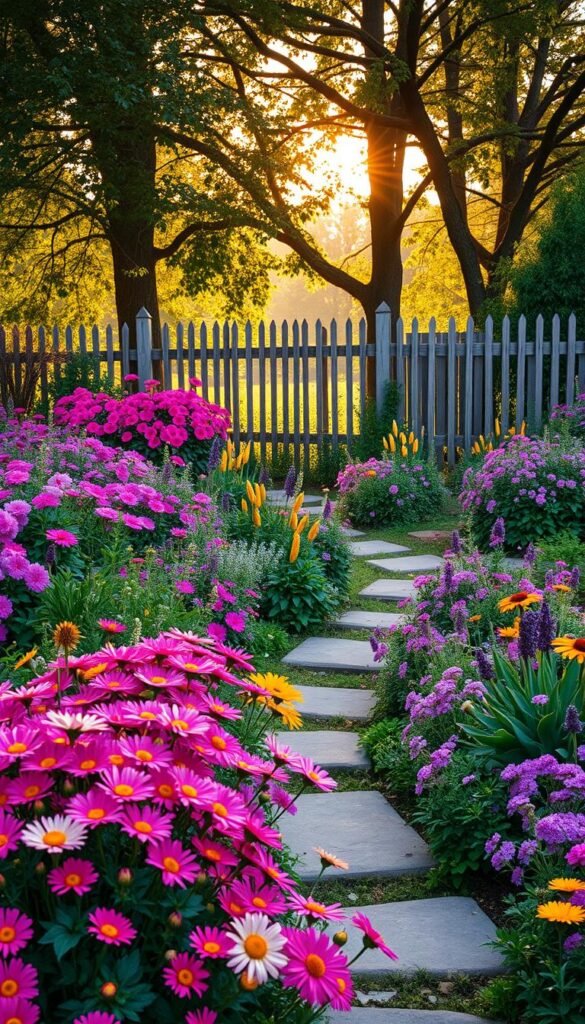
Transform your outdoor space into a living canvas by playing with nature’s palette. Smart placement and creative combinations turn ordinary beds into eye-catching displays that evolve daily.
Planting Strategies for Maximum Impact
Start with hydrangeas—their color-changing blooms act as natural pH meters. Acidic soil gives you blue flowers, while alkaline conditions create pink or lavender shades. Pair them with roses that offer endless variety, from fragrant English types to bold grandifloras.
Use height to create drama. Low-growing yarrow in fiery reds anchors the front, while alliums shoot up 30-inch purple spheres behind them. This layering guides the eye upward, making small spaces feel larger.
Mixing Textures and Colors
Combine feathery asters with broad hosta leaves for contrast. A single aster variety can serve as ground cover or backdrop—choose dwarf types for borders or towering eight-foot specimens for structure.
Repeat key colors across seasons. Soft pink roses in summer echo autumn sedum blooms, while white yarrow flowers mirror spring daisies. This creates rhythm without monotony.
Remember: foliage matters as much as flowers. Silver lamb’s ear leaves make purple coneflowers pop, while burgundy heuchera adds depth to green landscapes. Your garden becomes a textured tapestry that delights even between bloom cycles.
Garden Planning for Early Spring Blooms
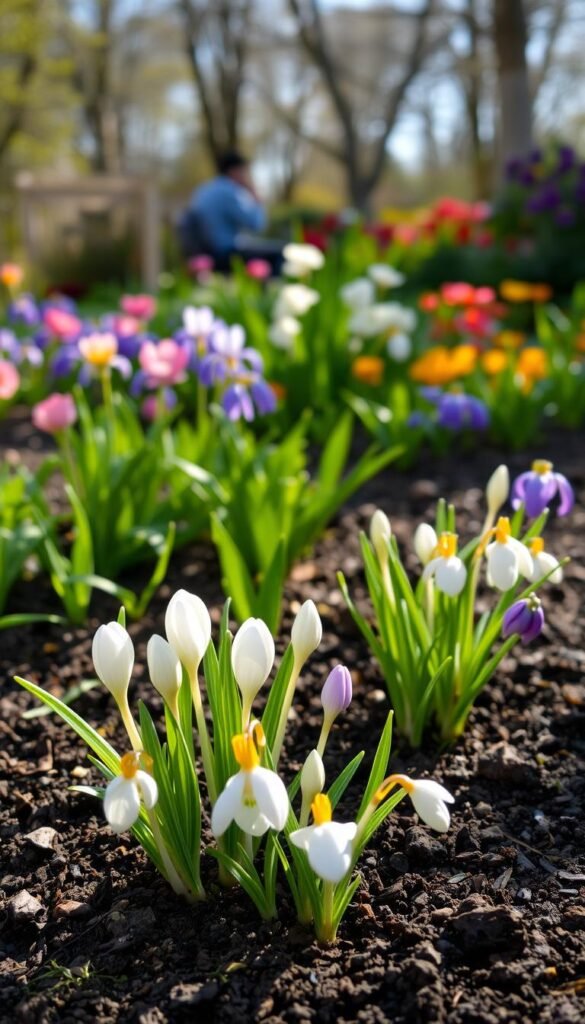
Nothing beats the thrill of seeing your landscape burst to life after winter’s chill. To achieve this, timing and plant selection matter most. Focus on bulbs that deliver bold colors when other plants are still waking up.
Bulb Powerhouses for First Signs of Life
Daffodils kickstart the show, pushing through snow in late winter. These hardy bulbs thrive in zones 3-8 and multiply yearly. Their trumpet-shaped flowers feed early bees while you enjoy weeks of sunny hues.
Tulips follow close behind, offering rainbow shades in early spring. Unlike daffodils, they may fade after 2-3 years. Plant them in clusters where you can easily refresh the display later.
| Feature | Daffodils | Tulips |
|---|---|---|
| Bloom Period | Late winter-early spring | Early spring |
| Longevity | 50+ years | 2-3 years |
| Soil Preference | Slightly acidic loam | Neutral, well-drained |
Pair these bulbs with emerging perennials like hostas. Their leaves will hide fading bulb foliage naturally. For best results, plant in fall—6 weeks before frost—and let winter’s cold work its magic.
Designing Your Garden for Late Spring to Early Summer
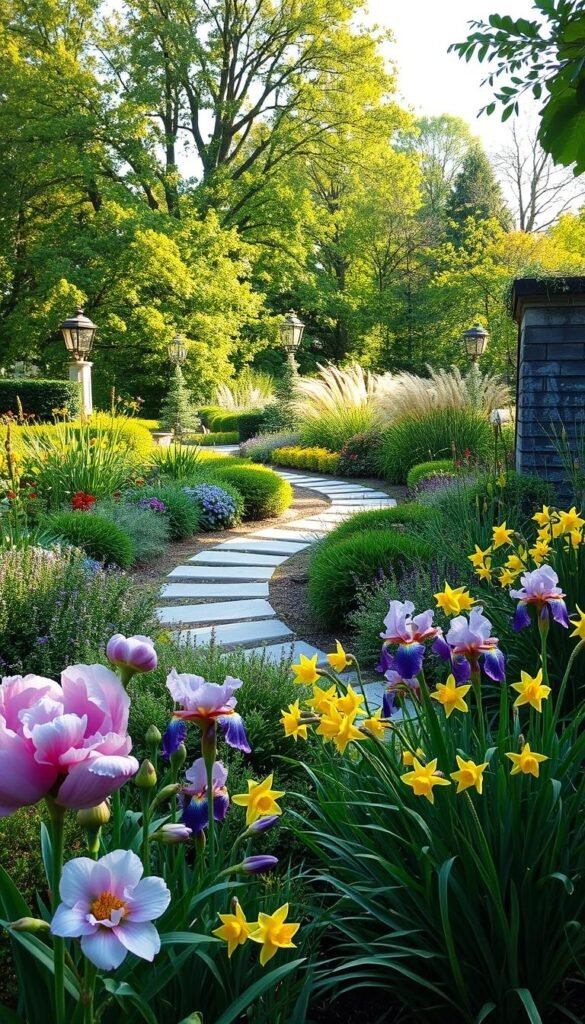
As temperatures warm and days lengthen, your landscape becomes a stage for nature’s most dramatic performers. This transitional period bridges spring’s finale and summer’s opening act, demanding plants that thrive in both cool nights and warm afternoons.
Spotlighting Early-Season Favorites
Bearded iris steals the show from late spring to early summer, unfurling intricate blooms in jewel tones. These pollinator magnets attract bees with their nectar-rich flowers, which last up to three weeks. Pair them with peonies, whose dinner-plate-sized blossoms fill the air with sweetness.
Roses offer marathon color when chosen wisely. Varieties like ‘Knock Out’ begin flowering in late spring and continue through fall. Their staggered buds ensure fresh blooms appear as older ones fade, creating constant visual interest.
| Plant | Bloom Period | Key Features |
|---|---|---|
| Bearded Iris | Late spring-early summer | Bee-friendly, drought-tolerant |
| Peony | Late spring-early summer | Fragrant, long-lived |
| Rose | Late spring-fall | Continuous blooms |
| Lavender | Late spring-early summer | Pest-repellent fragrance |
Lavender works overtime during this period. Its silvery foliage contrasts beautifully with brighter flowers, while its scent naturally deters unwanted insects. Plant it near seating areas to enjoy its calming aroma.
Support heavy bloomers with discreet stakes before buds form. Remove spent iris flowers promptly to redirect energy to roots, and trim lavender lightly after its first flush to encourage bushier growth. These simple steps keep your display vibrant through the early summer heat.
Tips for Managing Full Sun and Partial Shade Areas
Balancing sunny spots and shady corners transforms tricky spaces into thriving plant habitats. Whether your yard bakes in afternoon glare or hides under tree canopies, strategic choices ensure every area shines.
Choosing Sun-Loving Versus Shade-Tolerant Perennials
Full sun areas (6+ daily hours) let bold bloomers like coneflowers and yarrow flourish. These light-hungry plants produce more flowers when soaked in sunshine—perfect for south-facing beds or open patios.
Shaded zones invite creativity with foliage. Hostas unfurl patterned leaves under trees, while Japanese painted ferns add ruby-red stems to dim walkways. For winter magic, hellebores bloom through snow with rose-like flowers.
Mix textures for depth. Pair feathery astilbe plumes with glossy hellebore leaves near fences. In sun-drenched spots, combine spiky lavender with mounding sedum. This contrast keeps your garden visually engaging across seasons.
Remember: even shade-tolerant plants need some light. Morning sun with afternoon shelter works best for most. Observe your space hourly—you might discover microclimates perfect for unique varieties!

